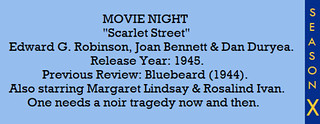 Review #1365: Scarlet Street.
Review #1365: Scarlet Street.Cast:
Edward G. Robinson (Christopher Cross), Joan Bennett (Katherine March), Dan Duryea (Johnny Prince), Margaret Lindsay (Millie Ray), Rosalind Ivan (Adele Cross), Jess Barker (David Janeway), Charles Kemper (Patch-eye Higgins), Anita Sharp-Bolster (Mrs. Michaels), Samuel S. Hinds (Charles Pringle), and Vladimir Sokoloff (Pop LeJon) Directed by Fritz Lang (#333 - M and #500 - Metropolis)
Review:
"Each picture has some sort of rhythm which only the director can give it. He has to be like the captain of a ship."
One can't forget about Fritz Lang when it comes to his diverse career of films, both in Germany and abroad. Born and raised in Vienna, Lang had a lengthy career, starting as a writer for film in 1916 before debuting as a director with Halbblut (1919). He met writer Thea von Harbou the following year, and they later married in 1922. They worked together in film for over a decade, which include films such as Dr. Mabuse the Gambler (1922), Metropolis (1927), M (1931, his first talking picture), and The Testament of Dr. Mabuse (1933). However, the two divorced due to an affair by Lang that same year. He would soon leave Germany owing to the rise of the Nazis, going to France (where he made one film in Liliom) before going to America. He made his American debut with Fury (1936), with his last in the country being Beyond a Reasonable Doubt (1956) before he returned to Germany (after thinking about retiring due to tough conditions to make further Hollywood films and growing age), where he made three films between 1959 and 1960, with his last being The Thousand Eyes of Dr. Mabuse before his death in 1976 at the age of 85. He was noted for his Expressionism (more so for his German films) alongside his talent in doing numerous genres, particularly with film noir.
The film was adapted (written by Dudley Nichols) from the French novel La Chienne by Georges de La Fouchardiere, which had already been played on the stage and in film in 1931 under its title by Jean Renoir (who notably disliked this film). This was the second time that Lang utilized this trio of actors, as they had appeared together in The Woman in the Window a year earlier. Both films had Robinson play a lonely middle-aged man and Bennett and Duryea play a criminal duo, and they even had the same choreographer in Milton R. Krasner. Robinson for his part did not like his experiences with either film, finding this one to be monotonous to do, although Lang found it to be one of his favorites to do. To each his own, one suppose - both of course do tremendous jobs in making a capable noir tick well. It goes to show how one can make something that plays numerous hands of deception to the benefit of its audience through 109 minutes, a clever experience with some psychological depth to it. It shouldn't prove too surprising that local authorities in three cities for censor boards objected to the content of the film, calling it many things besides "obscene". After all, it isn't exactly a noir with a happy ending, nor is it one that requires so. Just the idea of a character getting away with a murder was in some minds enough to object to, beyond portraying some sort of sordid life or illicitness with love. In other words, one needs a bit of risk sometimes to make things work better than a conventional film would do, with the best noirs utilizing imagination to give the viewer something to look into without needing things spelled out for them. Robinson does well with making an ordinary presence come into focus that we can follow along with to a point as a meek man that doesn't seem cartoonish or underplayed. Bennett and Duryea make for a conniving duo, ones with some luring power alongside a rough nature with chemistry. One can follow the film along without too much trouble, wrapped with a few twists that keep the viewer wanting more without displeasing them with where it needs to get to with its daring ending, where one can certainly find a prison for themselves without needing a conviction to do so. Lang certainly made plenty of memorable films, and this is one that is good to highlight, particularly since it is readily available through the public domain for anyone to view for themselves, a worthwhile little gem for the decade.
Overall, I give it 8 out of 10 stars.

No comments:
Post a Comment